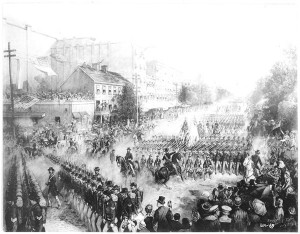ndianapolis continued to be draped in sorrow as the month began. The city hall, “profusely decorated” with wreaths, garlands, streamers, and flags, stood along with commercial buildings festooned with the colors of the national banner and portraits of Lincoln, shrouded in mourning. Black and white cloth trimmed windows and cornices and portraits of Grant, Morton, and Sheridan were also on general display. Many private homes were “handsomely and appropriately decorated.” Street cars bore mottoes — “Sorrow for the Dead; Justice for the Living; Punishment for Traitors” — “Too Good for Earth, to Heaven thou art Gone, and Left a Nation in Tears.” All emblems of mourning remained in the Hoosier capital “until after the final internment” of President Lincoln at Springfield. The afternoon of the funeral, city businesses closed at 3:00 p.m. “as a mark of respect to our late President” while funeral ceremonies were conducted at the State House to coincide with the somber rites in Illinois. The State House decorations — “bits of silver fringe, buttons, stars and tassels” — were sold at auction later in the month with the “fine oil painting of President Lincoln by Miss Underhill, of this city,” being sold to Mr. Sawyer for $150 (2014: $2,287.33). Lincoln’s Requiem, a “very beautiful and appropriate” piece of music composed by James A. Butterfield was available at the author’s music room, 22 S. Meridian St.
Voters were urged to cast their ballots in the city election on Tuesday, May 2. The Journal observed that the “growth, wealth, and influence” of Indianapolis “makes our city elections more important to our immediate interests than even the choice of State officers.” The Union Party nominees had been selected “by a popular vote of its members” a few weeks earlier and, except for a scattering of “independent or bolting candidates,” it offered the only ticket. The vote was small, only about 2,400 were polled in all.
As Brigadier General Thomas G. Pitcher, state provost marshal general, was receiving orders from Secretary of War Edwin Stanton to immediately muster out of the service and honorably discharge “all recruits, drafted men and substitutes, and volunteers,” Hoosiers read the “particulars” of the steamboat Sultana explosion. Newspaper columns were carefully scanned for the names of Indiana soldiers who “escaped death” from this “appalling disaster” and those who painfully perished. Governor Morton received permission to discharge Indiana soldiers now in the state on furlough and those injured arriving in the state from the Sultana disaster. At a rate of one hundred per day, the nineteen hundred rebels at Camp Morton were taking the oath of allegiance. In more than two columns of The Journal, citizens learned the names of Indiana soldiers who died at the Andersonville, Georgia prison camp in February and March of this year.
THE BOYS ARE COMING HOME! — Following the Grand Review of the Armies in Washington, DC, the mustering out of the troops began. It will be sometime after the first of June before any Hoosier soldiers reach Indianapolis. Six companies of the 22nd Veterans Reserve Corps left for Columbus, Ohio, their duty in this city at an end. Citizens thronged the streets, ladies waving handkerchiefs, as the troops marched to the Depot “amid the huzzas of the people.” Citizen meetings were held at the Court House, Roberts Chapel, and the Tabernacle during the last half of the month to form a society “to provide for a State Soldiers’ Home.”
The capture of Jeff Davis “caused some considerable excitement” on the city’s streets. William A. Bowles, Lambdin P. Milligan, and Stephen Horsey were scheduled to be hanged May 19, but the execution of Bowles and Milligan was suspended until June first. Horsey’s sentence was commuted to life imprisonment. The judges of the United States Circuit Court, now sitting in Indianapolis, certified a division of opinion on the application of a writ of habeas corpus for Bowles and Milligan in order that the case may be heard by the United States Supreme Court. THE CONSPIRACY TRIALS of Booth’s confederates was prominently featured in the columns of The Journal.
Indianapolis residents found relief in various amusements. In the early days of the month at the Tabernacle, two hundred and fifty performers — teachers and public school pupils — presented The Great Rebellion, “an operatic drama” which “was a triumphant success.” Thursday, Friday, and Saturday at mid-month immense crowds packed into the tent on the lot north of the Terre Haute Depot (Louisiana and Tennessee [Capitol Av]) for performances of the Great Union Combination Circus. Earlier, costumed performers had “attracted considerable attention” as they paraded through the city streets. Tuesday, May 30 the first Strawberry Festival of the season was held. “An abundance of luscious strawberries, delicious ice cream, good music, pretty women, and other creature comforts” sustained an enthusiastic crowd that turned out for the benefit of the Fourth Presbyterian Church, southwest corner Market and Delaware.



